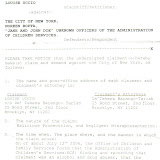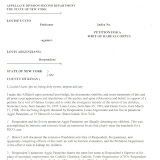The News Tribune (Tacoma, Washington)
M. ALEXANDER OTTO
May 11th, 2008
Concerned about how anti-psychotic drugs are being used in children, state officials are working on a plan due out by early fall to make sure the medications are properly prescribed for Washington kids on Medicaid.
“The data is concerning,” said Dr. Jeffrey Thompson, chief medical officer for the state Medicaid program and an expert in pharmaceutical trends in the state’s Medicaid population.
The long term safety and effectiveness of the drugs in children are not known, he and others say.
“We are at risk of treating kids before we know if these drugs are safe in the long-term,” said Dr. Christopher Varley, a University of Washington professor of child and adolescent psychiatry.
The drugs are used to treat such conditions as bipolar disorder or schizophrenia. They’re sold under the names Zyprexa, Geodon, Risperdal, Abilify, Seroquel, Clozaril and Invega.
The drugs belong to a relatively new class of anti-psychotics called “atypical.” The older class of anti-psychotics has been on the market for decades.
So far, the federal Food and Drug Administration has approved only Risperdal and Abilify for use in children, and only for the short term. All have been approved for adults. Doctors are free to prescribe drugs to anyone and in any way they see fit once they have been approved for some purpose.
In the past, anti-psychotic drugs were used mostly in adults, and mostly to treat schizophrenia. Long-term use of the “atypical” drugs in adults has been linked to serious side effects, including significant weight gain, diabetes, permanent involuntary movement disorders and even early death.
TROUBLING STATISTICS
State data show that the use of atypical anti-psychotics in children enrolled in Washington’s Medicaid program for low-income people increased about 25 percent between 2004 and 2007.
In 2007, 4,978 Medicaid participants 18 or younger were taking the drugs, and 187 were 5 or younger. Some children were on two or more drugs at the same time.
The most recent data available show that the state Medicaid program spent about $9.08 million last year on the drugs for children 18 or younger, up from $4.96 million in 2004.
Statistics on use of the drugs in Washington children not taking part in Medicaid are unavailable. Their use in children nationally has increased more than six-fold in the past 15 years, Varley said.
There are indications, Thompson said, that the drugs are sometimes being used when not needed, in doses sometimes too high, and in children who are too young for them.
USE THE ADHD MODEL, DOCTOR SAYS
Thompson is leading a work group in the state Department of Social and Health Services that seeks to ensure the drugs are prescribed to Medicaid children in Washington only when truly needed and at proper dosages.
The linchpin of the plan is the requirement of an expert second opinion if the drugs are prescribed outside of certain parameters: for instance, to very young children, or in combination, or in very high doses.
Some kids are on “doses that are far beyond any reasonable maximum dose,” said Varley, who is a member of the DSHS work group.
Such a plan already is in place for drugs to treat attention deficit hyperactivity disorder, or ADHD. The plan has helped standardize the use of stimulants such as Ritalan since 2005, when similar concerns were raised about ADHD drugs being used inappropriately in Medicaid children.
Among the chief drivers behind the use of atypical anti-psychotics in children, experts say, is the increasing popularity of bipolar disorder diagnoses. Bipolar disorder was previously known as manic depression.
Between 1994 and 2003, the number of children treated for bipolar disorder in the United States increased to more than 800,000 from 20,000, according to researchers.
The treatment trend is defended by some, questioned by others.
“Bipolar disorder is a very debilitating disease,” said Jamaison Schuler, a spokesman for Eli Lilly, which makes Zyprexa. “The earlier you can capture it, the better off you are.”
DOCTOR QUESTIONS DIAGNOSES
Zyprexa, like most of the atypical anti-psychotics, is not approved for children. Schuler said the company has produced data to support that use and has submitted them to the FDA.
For now, though, “to the extent doctors might be prescribing it (for children),” they are doing so without the data, Schuler said.
Among those who question the widespread use of atypical anti-psychotics in children and the popularity of bipolar diagnosis of kids is Dr. John Holttum. The Tacoma child psychiatrist treats 300 to 400 children a year, almost all referred to him by family doctors and general psychiatrists for additional help.
“At times, yes, (atypical anti-psychotics) help,” Holttum said. “Kids do get psychotic, and they do have mania, but both are very rare.”
What he sees more in his practice, he said, are violent or aggressive children who are labeled as bipolar, but who do not show the traditional signs of mania, depression and delusions of grandeur that are hallmarks of the traditional definition of bipolar disorder in adults.
He and others say the definition of bipolar disorder is expanding and now captures children who 10 or 15 years ago might have been seen as troubled or irritable, and more likely treated with counseling, parenting training for their caregivers or other social interventions.
Furthering the trend is extensive marketing of atypical anti-psychotics by the companies that make them, and media coverage of bipolar disorder as a childhood disease.
“Almost everybody in the field would agree there’s been a relative underrecognition of bipolar in children and adolescents over the past two decades,” Varley said. “But I’m skeptical of the way bipolar disorder is being used in terms of this new conceptualization.”
Holttum has seen the effects in his office on Division Avenue in Tacoma. He said he used to struggle to persuade parents to put their children on an anti-psychotic drug in the rare cases he thought one was needed.
But now, he said, “people come in and tell me (their child) is bipolar. I spend a lot of time convincing parents to remove that diagnosis, and explaining they have a child that is just angry.”
He also spends a lot of time taking children off atypical anti-psychotics, sometimes replacing them with antidepressants or ADHD drugs that have fewer side effects.
“We absolutely need some oversight” of atypical anti-psychotic use in children, Holttum said. “Some of the kids who walk into my office have been grossly mismanaged.”
Atypical anti-psychotics “are aggressive medications,” he said, and their potential long-term side effects on developing brains worry experts.
Holttum said atypical anti-psychotics are useful in the short-term to calm violent children before switching them to other drugs or looking for other solutions. Overall, though, “not a lot of children with unstable moods are bipolar,” Holttum said.
By early fall, the state Department of Social and Health Services will issue guidelines for the appropriate age and dose of anti-psychotic drugs for children whose medical bills are covered by the state’s Medicaid program.
Use of the drugs outside the parameters – using more than one of the “atypical anti-psychotics” at high doses in a child under 5, for instance – will trigger a review by an expert.
Either the pharmacy dispensing the drug or the prescriber will be required to alert the state and get a second opinion before the drug can be dispensed.
Dr. Jeffrey Thompson, head of the state’s Medicaid pharmaceutical program, is working on the plan with psychiatrists and others in the mental health community.
The hope, he said, is to make the system as user-friendly as possible for doctors and patients, so there’s no delay in care.
Over the past three years, a similar approach to curb inappropriate use of stimulants in children with attention deficit hyperactive disorder found that required second opinions resulted in a change in drug dosage or the treatment plan 56 percent of the time.
For ADHD drugs, Thompson said, the program resulted in fewer young children being prescribed stimulants, fewer given multiple ADHD drugs at a time, and lower doses.
“Now we are working with the mental health community for the same thing with anti-psychotics,” he said.
The plan was triggered in part by a wide-ranging law to improve mental health care for children, signed by Gov. Chris Gregoire in May 2007.
The law required DSHS to “set standards for reducing the number of children that are prescribed anti-psychotic drugs and receive no outpatient mental health services with their medication.”
To meet the second goal, on July 1 the department will bump up the number of mental health visits the agency covers for participants 12 to 20, so that stress factors, family situations and other problems can be more thoroughly addressed before they lead to psychiatric symptoms.
Original Article-
http://www.thenewstribune.com/front/topstories/story/357476.html
Subscribe to:
Post Comments (Atom)























No comments:
Post a Comment